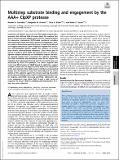| dc.contributor.author | Saunders, Reuben A | |
| dc.contributor.author | Stinson, Benjamin M | |
| dc.contributor.author | Baker, Tania A | |
| dc.contributor.author | Sauer, Robert T | |
| dc.date.accessioned | 2021-10-27T19:52:58Z | |
| dc.date.available | 2021-10-27T19:52:58Z | |
| dc.date.issued | 2020 | |
| dc.identifier.uri | https://hdl.handle.net/1721.1/133462 | |
| dc.description.abstract | © 2020 National Academy of Sciences. All rights reserved. Escherichia coli ClpXP is one of the most thoroughly studied AAA+ proteases, but relatively little is known about the reactions that allow it to bind and then engage specific protein substrates before the adenosine triphosphate (ATP)-fueled mechanical unfolding and translocation steps that lead to processive degradation. Here, we employ a fluorescence-quenching assay to study the binding of ssrA-tagged substrates to ClpXP. Polyphasic stopped-flow association and dissociation kinetics support the existence of at least three distinct substrate-bound complexes. These kinetic data fit well to a model in which ClpXP and substrate form an initial recognition complex followed by an intermediate complex and then, an engaged complex that is competent for substrate unfolding. The initial association and dissociation steps do not require ATP hydrolysis, but subsequent forward and reverse kinetic steps are accelerated by faster ATP hydrolysis. Our results, together with recent cryo-EM structures of ClpXP bound to substrates, support a model in which the ssrA degron initially binds in the top portion of the axial channel of the ClpX hexamer and then is translocated deeper into the channel in steps that eventually pull the native portion of the substrate against the channel opening. Reversible initial substrate binding allows ClpXP to check potential substrates for degrons, potentially increasing specificity. Subsequent substrate engagement steps allow ClpXP to grip a wide variety of sequences to ensure efficient unfolding and translocation of almost any native substrate. | |
| dc.language.iso | en | |
| dc.publisher | Proceedings of the National Academy of Sciences | |
| dc.relation.isversionof | 10.1073/PNAS.2010804117 | |
| dc.rights | Article is made available in accordance with the publisher's policy and may be subject to US copyright law. Please refer to the publisher's site for terms of use. | |
| dc.source | PNAS | |
| dc.title | Multistep substrate binding and engagement by the AAA+ ClpXP protease | |
| dc.type | Article | |
| dc.contributor.department | Massachusetts Institute of Technology. Department of Biology | |
| dc.contributor.department | Howard Hughes Medical Institute | |
| dc.relation.journal | Proceedings of the National Academy of Sciences of the United States of America | |
| dc.eprint.version | Final published version | |
| dc.type.uri | http://purl.org/eprint/type/JournalArticle | |
| eprint.status | http://purl.org/eprint/status/PeerReviewed | |
| dc.date.updated | 2021-07-14T12:40:07Z | |
| dspace.orderedauthors | Saunders, RA; Stinson, BM; Baker, TA; Sauer, RT | |
| dspace.date.submission | 2021-07-14T12:40:08Z | |
| mit.journal.volume | 117 | |
| mit.journal.issue | 45 | |
| mit.license | PUBLISHER_POLICY | |
| mit.metadata.status | Authority Work and Publication Information Needed | |
